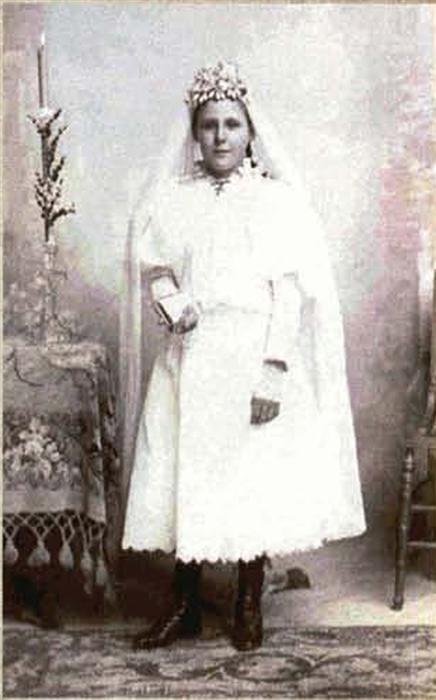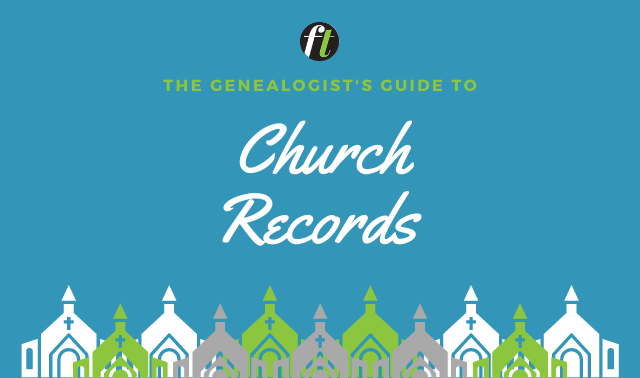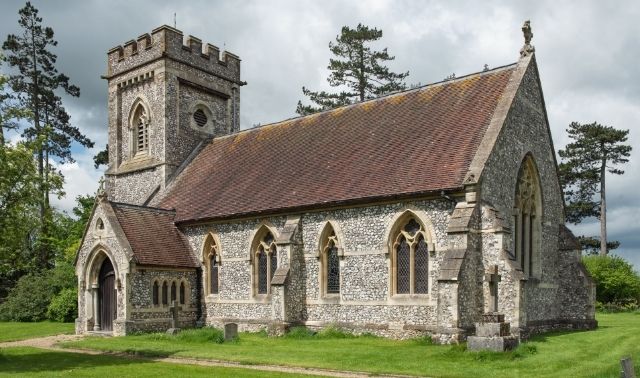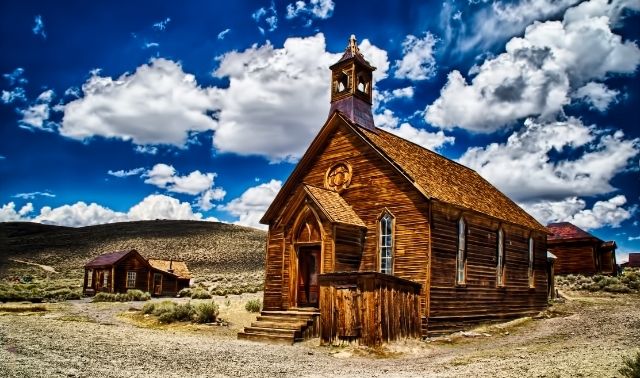Sign up for the Family Tree Newsletter Plus, you’ll receive our 10 Essential Genealogy Research Forms PDF as a special thank you!
Get Your Free Genealogy Forms
"*" indicates required fields
Heaven only knows what you might learn about your family history from church records, an often-overlooked genealogy resource (at least for US research). For example, because many of the men in my mother’s family during the late 1800s and early 1900s were Methodist ministers, I was able to find in a church history this vivid description of my great-great-uncle’s unusual death:
Dr. Dickinson’s death ‘came suddenly, tragically, unexpectedly; but it found him ready.’ Instantly killed in the fearful cyclone which swept the city of Enfaula on March 5, 1919, he was on the Master’s business when the summons came. Just a moment before the walls of the building into which he had gone on business for the church fell before the fury of the storm, one who was with him cried out, ‘Dr. Dickinson, what shall we do?’ Quietly he replied, ‘We are in the hands of the Lord.’ With this confession of faith on his lips he went away to he with his Lord forever.
Even if you don’t discover your ancestors’ stories in such heavenly detail, church records might hold answers to puzzles you thought you didn’t have a prayer of solving. Before the advent of official government vital records — whether in the United States or in your ancestors’ native lands — churches filled the role of local record-keeper. Depending on the place and the denomination, the church may have recorded not only such religious events as baptisms, marriages and burials, but also comings and goings from the region or even the country. In addition to (or in place of) government enumerations, you’ll find churches that kept censuses of a sort — member lists, tithing records, even household lists. Churches maintained orphanages and schools, and published newspapers and congregational histories, as well.
But family history researchers often miss these records as we fixate on the varieties of government paperwork. And church documents’ locations may be less obvious — it’s not exactly like going down to the county courthouse. You might not even know what kind of church Great-grandpa attended, so how can you begin to find any records it kept on him?
A little detective work can overcome these religious roadblocks and lead you to revelations about your family history. Let’s look at six simple steps to start using church records.
1. Locate where your ancestors lived
This might seem a strange first step for delving into religious resources, but — just as with most government records — church records depend on geography. Knowing your great-great-grandmother was a devout Presbyterian won’t help you much if you don’t also know where she attended church. Even if her church records have been moved to some denominational archive or microfilmed by the Church of Jesus Christ of Latter-day Saints’ Family History Library (FHL) in Salt Lake City, they’ll be filed by location.
So start by putting your ancestors on the map, using such familiar genealogical tools as census records, city directories and vital records. Don’t forget to interview relatives and pore over family letters and papers. Try to pinpoint your ancestors’ locales as narrowly as possible, particularly if they lived in a big city: In the days before horseless carriages, after all, people tended to go to church close to home. In small towns, denominational differences may have been moot; if there was only one Protestant church, your ancestors may have attended there even if they were technically Episcopalians and the church was Congregationalist.

2. Discover your ancestors’ denomination
The history of religion since the Protestant Reformation makes even the most convoluted family tree look as simple as a stick. From the days when the Western world was pretty much either Roman Catholic, Eastern Orthodox or Jewish, Christianity has splintered into hundreds of offshoots, large and small. Even within the history of the United States, various religious movements have sprung up and swept through the population, turning a relatively orderly denominational map into a crazy quilt of faiths. Your ancestors may have come here seeking religious liberty, and brought with them some new twist on churchgoing.
Maybe you already know that your ancestors were German Reformed or Church of the Brethren or Swedenborgian, in which case you have a huge head start on finding their church records. Don’t be too certain about your family’s religious past, however: Even before today’s a la carte approach to religion, factors ranging from marriage to moving to “seeing the light” led people to switch faiths. You may think everyone in your family has always been Baptist, but your research may uncover a relative who had a fling with the Jehovah’s Witnesses or a great-grandfather who left the Catholic church when he married your great-grandmother.
My fifth-great-grandfather William Few (1714-1794), for example, left Quaker Pennsylvania for Catholic Maryland, where he met and married the daughter of a well-to-do planter and devout Catholic. Several years after his marriage, however, he moved again to Georgia and switched to the Methodist church. His son, William Few Jr., a signer of the Constitution, somehow wound up buried in a Dutch Reformed church cemetery. A grandson, Ignatius Alphonso Few Jr., founded Emory University, a prominent college of the Methodist church — though he was an agnostic until age 37.
If you don’t know your ancestors’ denomination, you may find clues in family artifacts and photos. Their ethnic origin can give you a good guess, too, though of course you need to stay open to the possibility of surprises. For example, people from France, Italy, Poland, Ireland, Spain and Portugal generally were Roman Catholic.
If you’re looking for records back in Europe, remember that the Catholic church was often the official record-keeper even for nonadherents; the Council of Trent in 1563 got parish priests into the vital-records business. German families were commonly Lutheran or Catholic. Scandinavians were overwhelmingly Lutheran; again, even if your ancestors wound up in a different church in America, the state Lutheran church would have kept records of them in Scandinavia, including “household inventories” that you can use like censuses. Your English ancestors likely attended the Church of England — another state church, with a 1538 act of Parliament requiring ministers to record baptisms, marriages and burials. On this side of the Atlantic, Church of England faithful became Episcopalians. Similarly, the official Scottish church translated into the Presbyterian church.
Don’t forget, though, that your ancestors may have emigrated to escape the dominant church back home. Many Quakers came from England, for example. (If you’re lucky enough to have Quaker ancestors, you’ll enjoy a wealth of meticulously kept records, including attendance at monthly meetings and records of “removals” when members migrated to another town.) Anabaptists, Mennonites and Baptists moved from Germany to places such as Pennsylvania to practice their faiths. The Protestant Huguenots fled France for religious freedom. Your Jewish ancestors may have come from almost any part of Europe.
The culture and history of your ancestors’ home in America can also help narrow your search for their denomination. A little understanding of American religious history becomes important here: In Colonial times, the Congregational church dominated New England, while the Episcopal church was most prevalent in the South. Maryland was founded by Roman Catholics seeking religious freedom; Pennsylvania, of course, began with William Penn’s Quakers.
The Dutch Reformed church was influential in early New York (which began as New Netherlands) and in New Jersey. When the Scots-Irish began to settle in Virginia, they brought their Presbyterian church with them. The Great Awakening of the mid-1700s swept away many established religious patterns and spread the Baptist and Methodist churches, especially through the South. By the early 1800s, the Baptists had become the nation’s largest Protestant group; the Methodists overtook them from about 1820 until 1920, when the Baptists again became the largest denomination.
Waves of immigrants brought their religions with them: Jews from Eastern Europe to the big cities; Lutherans from Germany and Scandinavia to the Midwest, Great Plains, Pacific Northwest and Texas; Catholics from Ireland, then from Italy and Eastern Europe, to cities from New York to Chicago. Some immigrants founded churches particular to their ethnic origins, such as the Polish National church, Greek and Russian Orthodox churches, and Swedish Baptist church. New denominations such as the Church of Jesus Christ of Latter-day Saints arose in the central states and moved west. Freed slaves had their own churches, such as the African Methodist Episcopal church, and their own congregations within such groups as the Baptists.
3. Find out which church your ancestors attended
Even if you haven’t been able to identity your ancestors’ denomination. don’t give up! Some of the following dues for narrowing your research to a specific church can let you jump right over that roadblock.
If you know where your ancestors Iived and to which denomination they belonged, however, finding the actual church they attended can sometimes be simple. If your ancestors were Catholics living in a small town with only one parish, naturally you should start your research there. Even if they lived in an urban area with many church choices, the closest church of the right denomination is likely to have your family’s records. Old maps and city directories can help you zero in on the place your ancestors worshipped.
But sometimes the search for your ancestors’ actual church can be tricky. When you hit a dead end, haul out your genealogical toolbox and look death certificates, marriage records baptismal certificates and family papers. Where were they married? Who performed the funeral service? Even if you can find only the name of a clergyman, not his church, that plus a city directory can often lead you to where the Rev. So-and-So preached — just look him up. Get creative in your detective work: Maybe Great-grandpa’s will reveals a bequest to the First Baptist Church of Pumpkin Center, SD. Still stumped? Branch out to your ancestors’ siblings and to cousins who lived nearby. If Cousin Pat who lived next door was buried by Father Flanagan of St. Mary’s, your Catholic ancestor’s records were probably kept by St. Mary’s, too.
4. Seek out the church records
If dear old St. Mary’s is still standing, if the records are still there, and if the current priest or church secretary feels cooperative, you just need to make an appointment or write a courteous request — and then start tapping this gold mine of ancestral information. But that’s a lot of ifs. The location of church records varies by denomination (in this example, Roman Catholic records typically remain with the parish, though a diocese may receive copies). Churches close, merge, move and burn down. Typically, though, surviving local records stay nearby; if your ancestors’ church has vanished, try other churches of that denomination in the area, which may have “inherited” the records. Remember, too, that church records, unlike those in the courthouse, are private — once you track it down, the church doesn’t have to share its records with you. Courtesy; patience; a self-addressed, stamped envelope for replies; and proof that you’re related to the churchgoer in question can go a long way toward prying those records loose. If you’re planning to research in person, never pop in without an appointment.
You may be able to study your ancestors’ church records without contacting the church — or even if you do try, but run into roadblocks. See if the church records you’re after can be found in the online Family History Library catalog (click the catalog link under Family History Library System). It’s possible to search by keyword, such as baptism, but that would get you 127,617 entries to wade through. A search by place narrows your results much faster, and will turn up other useful, non-church records on microfilm, as well.
On the other hand, if you’re really certain about the name of your ancestral church, you can try a keyword search with terms from the church name to zoom in on these records. Did your ancestor attend Dry Dock Methodist Episcopal Church in New York City? A keyword search for Dry Dock Episcopal will take you straight to the details of films 17779 through 17782, which include marriage, baptism and burial records from the mid-1800s.
If your ancestors’ church records haven’t been microfilmed, perhaps they’ve been transcribed and published. Search the Periodical Source Index (PERSI), available at many libraries, for genealogy journals that may have printed the records you’re after. Then, borrow the publication via interlibrary loan or get a photocopy from the Allen County Public Library ($7.50 plus 20 cents per page for up to six articles). For example, the Southern Indiana Genealogical Society Quarterly published records of German Methodist marriages from 1883 to 1907 — maybe your Hoosier Methodists are there.
Actual church records haven’t come online as quickly as some resources, but it’s still worth a look to see if your ancestors’ religious records have been transcribed or digitized on the Web. The free USGenWeb site is a good place to start: Maybe a Good Samaritan has transcribed the records you’re after, such as the Index to the Emanuel Lutheran Church Records of Tawas City, Mich., 1877-1996, or the membership roster (1824 to 1910) of the Mount Paron Primitive Baptist Church in Crawford County, Ga. You also can find a wealth of sites for specific churches and denominations at Cyndi’s List.
Other church records can be found on subscription sites such as those offered by Ancestry.com, Findmypast and MyHeritage. On Ancestry.com, under Birth, Marriage & Death Records, you’ll find thousands of church records, such as those of Sherman’s Union Church in York County, Pa. (1751 to 1800) and the Encyclopedia of American Quaker Genealogy, covering the 455,000 members of the Society of Friends before 1850.
5. Check archives, libraries and historical societies
Even if the church and its records are long gone from your ancestors’ locality, and you strike out on microfilm and online, it may not take a miracle to find the records you want. They might have been moved to a regional or denominational archive, a seminary or some other church institution. You’ll find many such archives in the Toolkit, or see the listings in The Source edited by Loretto Dennis Szucs and Sandra Hargreaves Luebking (free on the Ancestry.com wiki).
Church records also can wind up at local and state libraries, colleges and universities (particularly those affiliated with the denomination), genealogical societies and historical societies. For example, the Wisconsin Historical Society is home to the register of baptisms and confirmations performed from 1856 to 1894 by the Rev. Abraham B. Peabody, an Episcopal clergyman serving the St. Croix River Valley — among many other church records. Start your search for church records gone astray with archives near the church or in the same state. You can also try the National Union Catalog of Manuscript Collections, compiled by the Library of Congress, which tracks what’s deposited where. See the website to learn more and to search the catalog from 1986 on.
6. Try other types of church records
Registers of baptisms, marriages and other life events are important finds among church records, but these are just the beginning of the genealogical treasures you can uncover if you look past the pews. Don’t neglect other records such as tithing lists, membership lists and records of such church milestones as confirmations, bar mitzvahs and first communions. Look for church-school records, mentions in parish newsletters and congregational histories. Cemetery searchers will often find success in church burial yards (which in turn can tell you which church your dearly departed ancestor likely attended).
Denominations also produced their own newspapers, with titles such as Southern Christian Advocate (from the Methodist Episcopal Church, 1837 to 1948) or Afro-American Presbyterian (1879 to 1938). You can find these and their possible mentions of your ancestors in archives, historical societies and the universities and seminaries of the denomination. Catholic newspapers, for example, are archived at Notre Dame University and the American Catholic Historical Society in Philadelphia. You can find some religious newspapers online at the free Chronicling America and the subscription-based Newspapers.com and GenealogyBank.com.
If you had ancestors who were ministers, married to ministers or otherwise prominent in the church, you might find them in published denominational histories and compilations of ministerial records. The Methodist church has an online index to 61,000 names found in the memoirs of Methodist ministers, for instance. You can bet I’m using it to see if any other family members were, er, heaven-sent by similarly extraordinary means.
A version of this article appeared in the February 2004 issue of Family Tree Magazine.
ADVERTISEMENT





